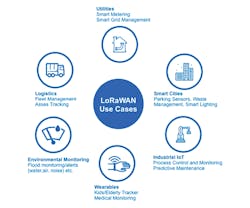Download this article in PDF format.
LoRa and LoRaWAN are quickly drawing global attention as a low-power wide area network (LPWAN) alternative to technologies like Sigfox, and gateways are springing up around the world. To the uninitiated, LoRa’s capabilities and potential are either a mystery, or completely unbelievable. It’s about time we dispel some of the misunderstandings or outright fallacies plaguing LoRa and LoRaWAN.
1. LoRa is LoRaWAN.
LoRaWAN is the communication protocol and system architecture for the network while LoRa is the physical radio layer enabling the long-range communication link. The LoRaWAN protocol and network architecture directly influence the battery lifetime of a node, network capacity, quality of service, security, and the variety of applications served by the network.
LoRa is the technology that modulates the data into electromagnetic waves. It uses a transmission method called “Chirp Spread Spectrum,” encoding data in frequency-modulated “chirps.” This transmission method has been used in military and space communication for decades.
2. LoRa signals can’t really transmit over 10 km. That’s nuts!
In a typical LoRaWAN network, range depends on numerous factors—indoor/outdoor gateways, payload of the message, antenna used, etc. On average, in an urban environment with an outdoor gateway, you can expect up to 2- to 3-km-wide coverage, while in the rural areas it can reach beyond 5 to 7 km. In some cases, extremely long range is also attainable—ref: 702 km!
LoRa’s range depends on “radio line-of-sight.” Radio waves in the 400- to 900-MHz range may pass through some obstructions, depending on their composition, but will be absorbed or reflected otherwise. This means that the signal can potentially reach as far as the horizon, as long as there are no physical barriers to block it. Elevating LoRa devices—placing them on rooftops or mountaintops, for example—will maximize their range. Other factors, such as antenna gain, will also have a large impact on range.
3. Okay, but there’s no way my device could last up to 10 years!
One of the unique features of LoRaWAN is long battery life. To achieve this, devices are generally programmed to go into deep sleep mode when not transmitting messages, maximizing battery life. The longevity of any node is still determined by the capacity of its battery, but going to sleep for extended periods will dramatically extend charge cycles.
Also, the LoRa signal itself doesn’t require a whole lot of power to generate and transmit. That means, even when the system is active and transmitting, power consumption is kept at a trickle. With a minimal amount of software tinkering, the Strata node from Gumstix idled at 20 mA in “idle” mode and topped out at less than 110 mA during transmission.
4. Can I share images/files on LoRaWAN?
The speed at which you can send data over LoRaWAN is extremely low. Don’t expect to send large files such as music, video, or images over this type of network. It’s suitable for extremely small sensor data packets that can be used for alarms, triggering, and monitoring purposes. This plays a huge factor in optimizing battery life.
5. LoRa nodes can only send data.
Another key feature of LoRaWAN is its ability to support bidirectional communication. This means that an end device (sensor) can send a message to the network (i.e., sensor data, occupancy, location) as well as receive messages from the network back to the device. Thanks to this, LoRa devices can be programmed or designed to deliver status indicators to remote locations.
A good application for this bidirectional long-range capability could be indicating if a bridge has been washed out on a back-country service road or hiking trail at the trailhead, so that crews and hikers can plan a new route. A floating switch, or humidity and pressure sensors, would detect if the bridge deck was submerged in water and transmit that data to a cloud service. This service, in turn, would send a trigger signal to the sign post node, which would operate a mechanism to indicate that the bridge is out.
6. LoRa isn’t secure.
Security has always been an important aspect for any wireless technology. LoRaWAN utilizes two layers of security: one for the network and one for the application. The network security ensures authenticity of the node in the network, while the application layer of security ensures the network operator doesn’t have access to the end user’s application data. AES encryption is used with the key exchange.
An added bonus is that low-power Chirp Spread Spectrum signals are very difficult to detect and intercept.
7. I have to pay to use LoRaWAN.
For people interested in getting started with LoRaWAN, there’s a global community of over 24,000 people in over 500 cities around the world making use of the open free network “The Things Network.” All you need is some end devices to start with, and you can start diving into LoRaWAN in a flash. In case you’re in an area with no coverage, you can always set up a base station, thereby providing coverage to not only yourself, but also to local members of your network.
Also, various paid networks can provide dedicated network or application servers that offer greater bandwidth, storage, and number of devices; additional privacy and security; and software licensing options.
8. LoRaWAN is for IIoT sensor monitoring. That’s it.
Not just limited to a few monitoring and alert messages, LoRaWAN over time has found applications ranging from smart cities to industrial IoT, manufacturing, and plenty of other verticals.
The architecture and key characteristics of the LoRaWAN core technology have expanded into new emerging applications across multiple industries.
9. But what about support from the industry?
The LoRaWAN standard is supported by a big alliance of companies, called the LoRa Alliance. This is pretty important for the future and adaptability across different industries. In a short span of three years, over 500 companies and organizations have become part of the LoRa Alliance.
10. There’s no way to track LoRa nodes without adding GPS receivers.
A very interesting feature of LoRaWAN is localization without the need of GPS. This is especially useful for tracking assets and sensors, since it’s very battery-efficient. LoRaWAN sensors can support tracking applications by using Differential Time of Arrival techniques to determine approximate location to the nearest city block.
This coarse-grained triangulation can be achieved when a device is transmitting to at least three gateways in a similar manner as GPS receivers. With foreknowledge of each gateway’s physical location and by detecting the difference in time between all of them as the signal arrives, an application can compute the approximate position of the signal’s origin. Ref: LinkLabs
11. I can’t find any ideal hardware for my application.
There are many commercial and development-oriented products, projects, and development options for a wide variety of applications. Commercially available, OTB (out-of-the-box) gateway solutions can be had from sources such as MultiTech, LinkLabs, and thethingsnetwork.org.
Development kits are available for gateway devices, too. Examples include the LoRa Evaluation Kit from Microchip and the Raspberry Pi Compute Module 3 and Overo Conduit kits from Gumstix. These kits provide developer-level access to the hardware and firmware found in LoRa gateways.
If the developer kits available on the market don’t meet with your requirements or expectations, there are alternatives like Gumstix’s Geppetto D2O. This online design-to-order system features a simple drag-and-drop module library of processors, sensors, networks, and more that can be designed into a single-board solution and shipped within 15 days of order. Geppetto can incorporate a connector module for the RisingHF RHF0M301 gateway and concentrator module into any board configuration.
When it comes to sensor nodes, the challenge becomes greater. Myriad shields and dongles exist for various sensors and inputs, but few dedicated products. Finding a product that matches the specifications of your application is going to be difficult. Therefore you may find yourself doing one of the following
- Assembling an ad-hoc node prototype from MCU boards, LoRa transceiver shields, and sensor devices.
- Investing engineering hours and resources designing and manufacturing prototypes.
- Ordering custom hardware from third parties, such as Geppetto from Gumstix (in addition to the RHF gateway module, Gepetto has a transceiver module incorporating Microchip’s RN2483 or RN2903).
In a nutshell, LoRa provides secure, bidirectional, low-power, long-range communication through both free and paid network services. Its wireless signals can reach across great distances, delivering tiny packets of data to and from multiple low-power node devices.
Rishabh Chauhan is the global community manager at The Things Network. He has a background in Electronics and Instrumentation engineering from India. Rishabh has been involved in various projects and not-for-profit organizations around the world. Before joining TTN, he was working in New Zealand, overseeing the development of new product, process improvement, and long-term directions between the universities and government. Currently, he oversees managing The Things Network communities around the world and takes an active role in scaling up the initiative further.
Keith Lee is a computer engineer and Gadget Guru at Gumstix Inc. He has a BASc and MASc in computer engineering and has a keen interest in embedded systems, SoCs, computer architecture, and logic design. Keith enjoys designing and creating tutorials for the latest IoT devices. You can follow his blog at gumstixgadgets.blogspot.ca.
References:
Democratizing LoRaWAN and IoT with The Things Network from Amazon Web Services
About the Author
Rishabh Chauhan
Global Community Manager
Rishabh Chauhan is the global community manager at The Things Network. He has a background in Electronics and Instrumentation engineering from India. Rishabh has been involved in various projects and not-for-profit organizations around the world. Before joining TTN, he was working in New Zealand, overseeing the development of new product, process improvement, and long-term directions between the universities and government. Currently, he oversees managing The Things Network communities around the world and takes an active role in scaling up the initiative further.
Keith Lee
Engineer and Gadget Guru
Keith Lee is a computer engineer and Gadget Guru at Gumstix Inc. He has a BASc and MASc in computer engineering and has a keen interest in embedded systems, SoCs, computer architecture, and logic design. Keith enjoys designing and creating tutorials for the latest IoT devices. You can follow his blog at gumstixgadgets.blogspot.ca.


